Management Accounting: Tools and Techniques for Planning and Decision Making
VerifiedAdded on 2022/12/27
|16
|3775
|50
AI Summary
This report discusses the importance of management accounting in providing specific information for decision making. It focuses on the tools and techniques used in planning, such as absorption and marginal costing methods. It also explores various management accounting techniques like cash budgeting, capital budgeting, and ratio analysis.
Contribute Materials
Your contribution can guide someone’s learning journey. Share your
documents today.
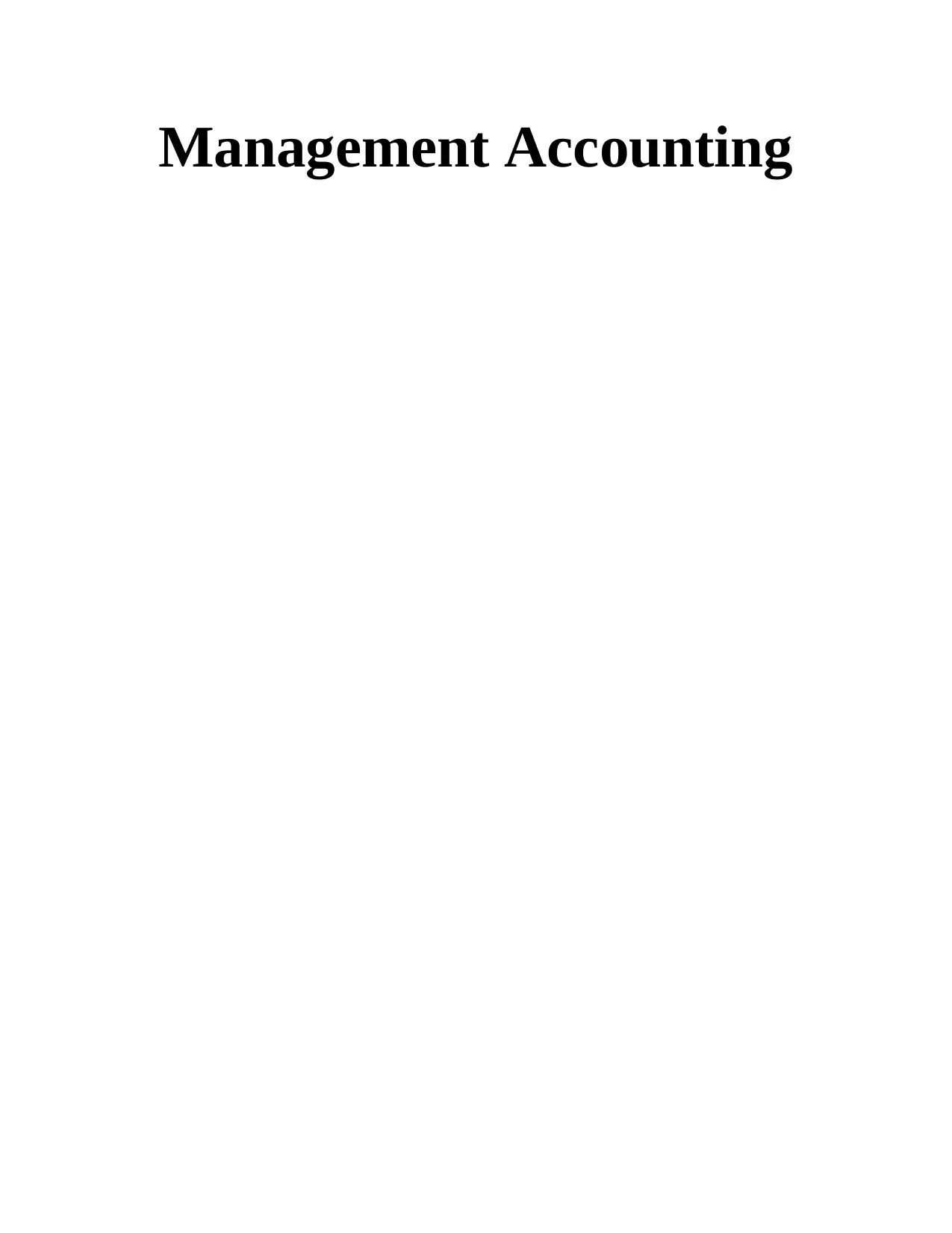
Management Accounting
Secure Best Marks with AI Grader
Need help grading? Try our AI Grader for instant feedback on your assignments.
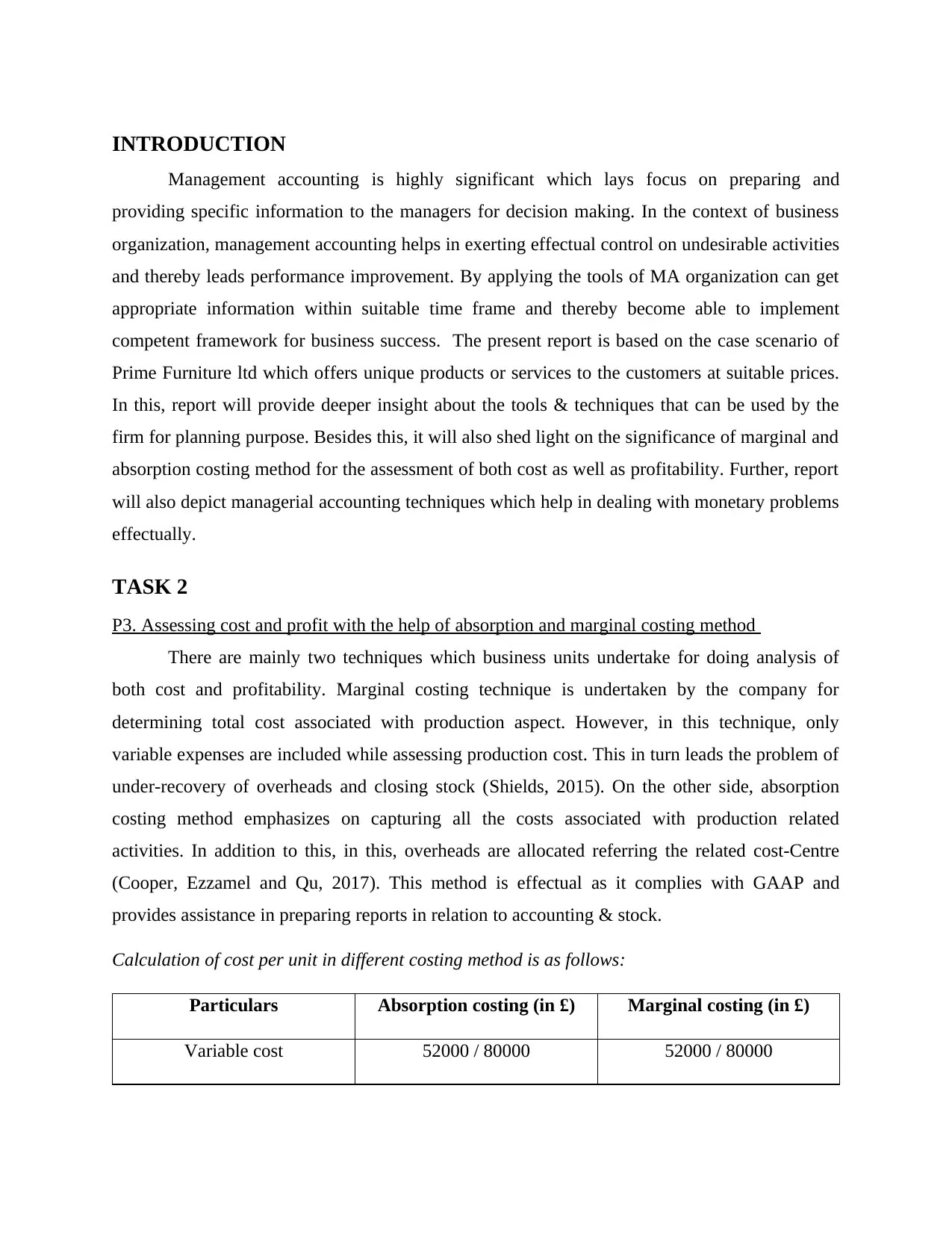
INTRODUCTION
Management accounting is highly significant which lays focus on preparing and
providing specific information to the managers for decision making. In the context of business
organization, management accounting helps in exerting effectual control on undesirable activities
and thereby leads performance improvement. By applying the tools of MA organization can get
appropriate information within suitable time frame and thereby become able to implement
competent framework for business success. The present report is based on the case scenario of
Prime Furniture ltd which offers unique products or services to the customers at suitable prices.
In this, report will provide deeper insight about the tools & techniques that can be used by the
firm for planning purpose. Besides this, it will also shed light on the significance of marginal and
absorption costing method for the assessment of both cost as well as profitability. Further, report
will also depict managerial accounting techniques which help in dealing with monetary problems
effectually.
TASK 2
P3. Assessing cost and profit with the help of absorption and marginal costing method
There are mainly two techniques which business units undertake for doing analysis of
both cost and profitability. Marginal costing technique is undertaken by the company for
determining total cost associated with production aspect. However, in this technique, only
variable expenses are included while assessing production cost. This in turn leads the problem of
under-recovery of overheads and closing stock (Shields, 2015). On the other side, absorption
costing method emphasizes on capturing all the costs associated with production related
activities. In addition to this, in this, overheads are allocated referring the related cost-Centre
(Cooper, Ezzamel and Qu, 2017). This method is effectual as it complies with GAAP and
provides assistance in preparing reports in relation to accounting & stock.
Calculation of cost per unit in different costing method is as follows:
Particulars Absorption costing (in £) Marginal costing (in £)
Variable cost 52000 / 80000 52000 / 80000
Management accounting is highly significant which lays focus on preparing and
providing specific information to the managers for decision making. In the context of business
organization, management accounting helps in exerting effectual control on undesirable activities
and thereby leads performance improvement. By applying the tools of MA organization can get
appropriate information within suitable time frame and thereby become able to implement
competent framework for business success. The present report is based on the case scenario of
Prime Furniture ltd which offers unique products or services to the customers at suitable prices.
In this, report will provide deeper insight about the tools & techniques that can be used by the
firm for planning purpose. Besides this, it will also shed light on the significance of marginal and
absorption costing method for the assessment of both cost as well as profitability. Further, report
will also depict managerial accounting techniques which help in dealing with monetary problems
effectually.
TASK 2
P3. Assessing cost and profit with the help of absorption and marginal costing method
There are mainly two techniques which business units undertake for doing analysis of
both cost and profitability. Marginal costing technique is undertaken by the company for
determining total cost associated with production aspect. However, in this technique, only
variable expenses are included while assessing production cost. This in turn leads the problem of
under-recovery of overheads and closing stock (Shields, 2015). On the other side, absorption
costing method emphasizes on capturing all the costs associated with production related
activities. In addition to this, in this, overheads are allocated referring the related cost-Centre
(Cooper, Ezzamel and Qu, 2017). This method is effectual as it complies with GAAP and
provides assistance in preparing reports in relation to accounting & stock.
Calculation of cost per unit in different costing method is as follows:
Particulars Absorption costing (in £) Marginal costing (in £)
Variable cost 52000 / 80000 52000 / 80000
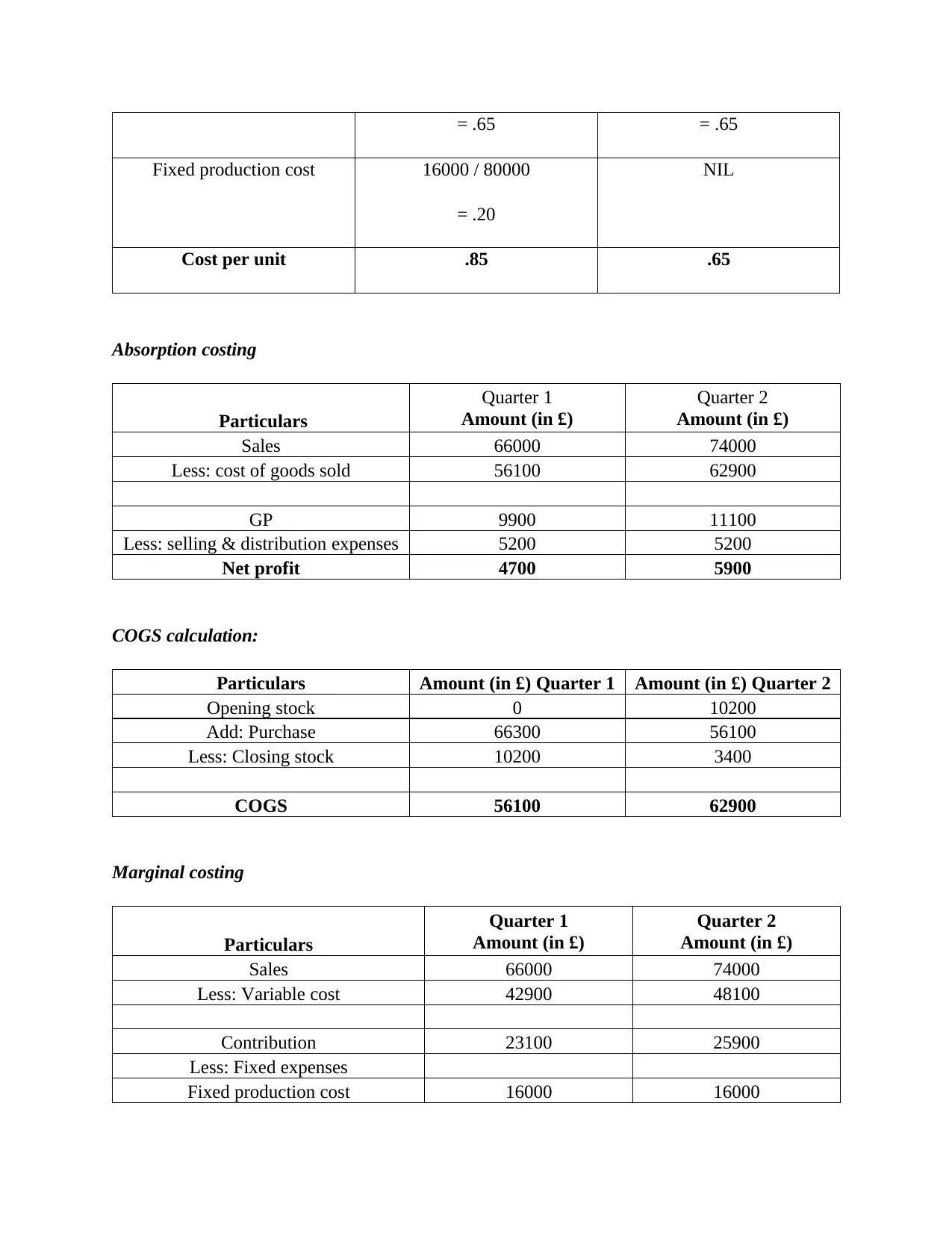
= .65 = .65
Fixed production cost 16000 / 80000
= .20
NIL
Cost per unit .85 .65
Absorption costing
Particulars
Quarter 1
Amount (in £)
Quarter 2
Amount (in £)
Sales 66000 74000
Less: cost of goods sold 56100 62900
GP 9900 11100
Less: selling & distribution expenses 5200 5200
Net profit 4700 5900
COGS calculation:
Particulars Amount (in £) Quarter 1 Amount (in £) Quarter 2
Opening stock 0 10200
Add: Purchase 66300 56100
Less: Closing stock 10200 3400
COGS 56100 62900
Marginal costing
Particulars
Quarter 1
Amount (in £)
Quarter 2
Amount (in £)
Sales 66000 74000
Less: Variable cost 42900 48100
Contribution 23100 25900
Less: Fixed expenses
Fixed production cost 16000 16000
Fixed production cost 16000 / 80000
= .20
NIL
Cost per unit .85 .65
Absorption costing
Particulars
Quarter 1
Amount (in £)
Quarter 2
Amount (in £)
Sales 66000 74000
Less: cost of goods sold 56100 62900
GP 9900 11100
Less: selling & distribution expenses 5200 5200
Net profit 4700 5900
COGS calculation:
Particulars Amount (in £) Quarter 1 Amount (in £) Quarter 2
Opening stock 0 10200
Add: Purchase 66300 56100
Less: Closing stock 10200 3400
COGS 56100 62900
Marginal costing
Particulars
Quarter 1
Amount (in £)
Quarter 2
Amount (in £)
Sales 66000 74000
Less: Variable cost 42900 48100
Contribution 23100 25900
Less: Fixed expenses
Fixed production cost 16000 16000
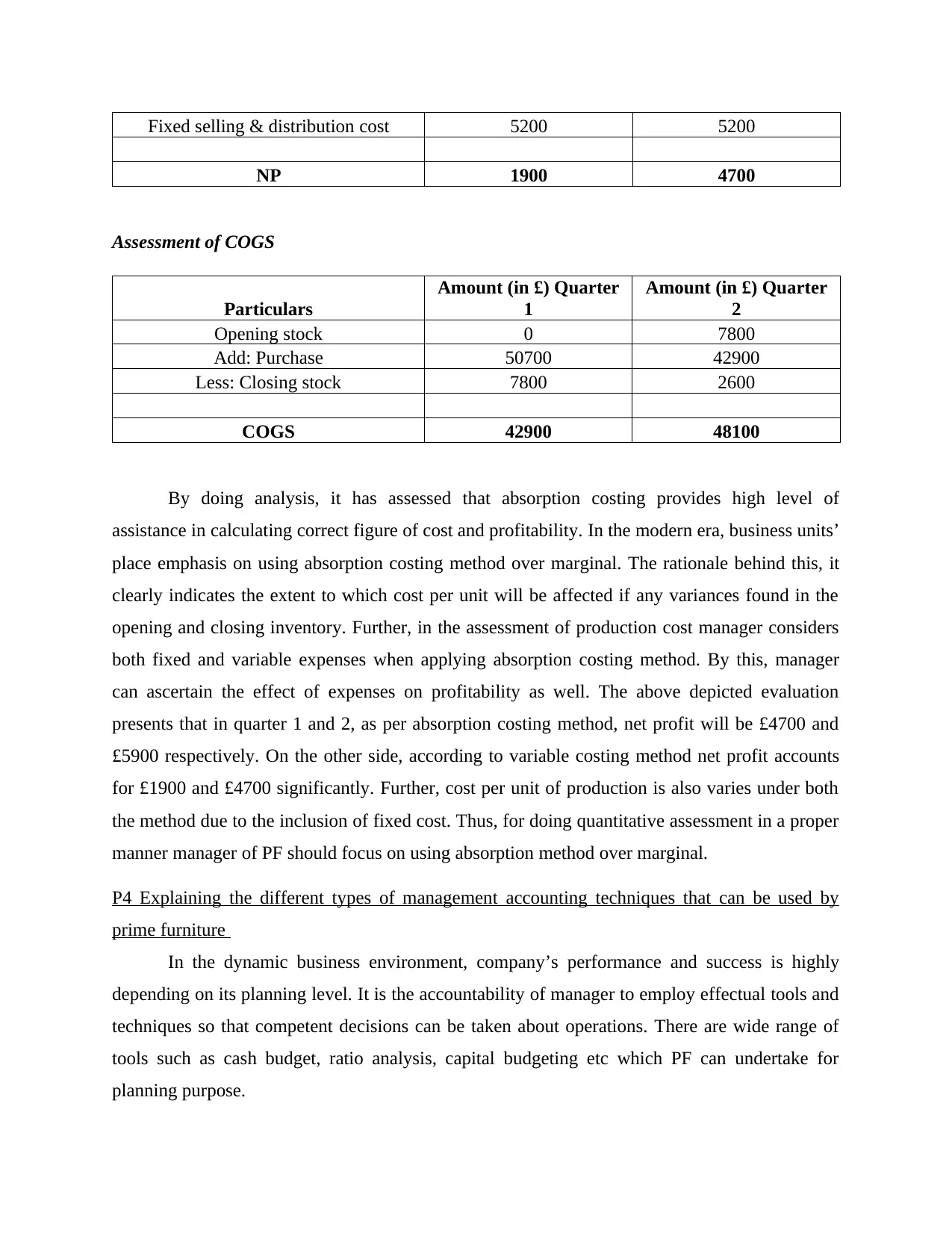
Fixed selling & distribution cost 5200 5200
NP 1900 4700
Assessment of COGS
Particulars
Amount (in £) Quarter
1
Amount (in £) Quarter
2
Opening stock 0 7800
Add: Purchase 50700 42900
Less: Closing stock 7800 2600
COGS 42900 48100
By doing analysis, it has assessed that absorption costing provides high level of
assistance in calculating correct figure of cost and profitability. In the modern era, business units’
place emphasis on using absorption costing method over marginal. The rationale behind this, it
clearly indicates the extent to which cost per unit will be affected if any variances found in the
opening and closing inventory. Further, in the assessment of production cost manager considers
both fixed and variable expenses when applying absorption costing method. By this, manager
can ascertain the effect of expenses on profitability as well. The above depicted evaluation
presents that in quarter 1 and 2, as per absorption costing method, net profit will be £4700 and
£5900 respectively. On the other side, according to variable costing method net profit accounts
for £1900 and £4700 significantly. Further, cost per unit of production is also varies under both
the method due to the inclusion of fixed cost. Thus, for doing quantitative assessment in a proper
manner manager of PF should focus on using absorption method over marginal.
P4 Explaining the different types of management accounting techniques that can be used by
prime furniture
In the dynamic business environment, company’s performance and success is highly
depending on its planning level. It is the accountability of manager to employ effectual tools and
techniques so that competent decisions can be taken about operations. There are wide range of
tools such as cash budget, ratio analysis, capital budgeting etc which PF can undertake for
planning purpose.
NP 1900 4700
Assessment of COGS
Particulars
Amount (in £) Quarter
1
Amount (in £) Quarter
2
Opening stock 0 7800
Add: Purchase 50700 42900
Less: Closing stock 7800 2600
COGS 42900 48100
By doing analysis, it has assessed that absorption costing provides high level of
assistance in calculating correct figure of cost and profitability. In the modern era, business units’
place emphasis on using absorption costing method over marginal. The rationale behind this, it
clearly indicates the extent to which cost per unit will be affected if any variances found in the
opening and closing inventory. Further, in the assessment of production cost manager considers
both fixed and variable expenses when applying absorption costing method. By this, manager
can ascertain the effect of expenses on profitability as well. The above depicted evaluation
presents that in quarter 1 and 2, as per absorption costing method, net profit will be £4700 and
£5900 respectively. On the other side, according to variable costing method net profit accounts
for £1900 and £4700 significantly. Further, cost per unit of production is also varies under both
the method due to the inclusion of fixed cost. Thus, for doing quantitative assessment in a proper
manner manager of PF should focus on using absorption method over marginal.
P4 Explaining the different types of management accounting techniques that can be used by
prime furniture
In the dynamic business environment, company’s performance and success is highly
depending on its planning level. It is the accountability of manager to employ effectual tools and
techniques so that competent decisions can be taken about operations. There are wide range of
tools such as cash budget, ratio analysis, capital budgeting etc which PF can undertake for
planning purpose.
Secure Best Marks with AI Grader
Need help grading? Try our AI Grader for instant feedback on your assignments.
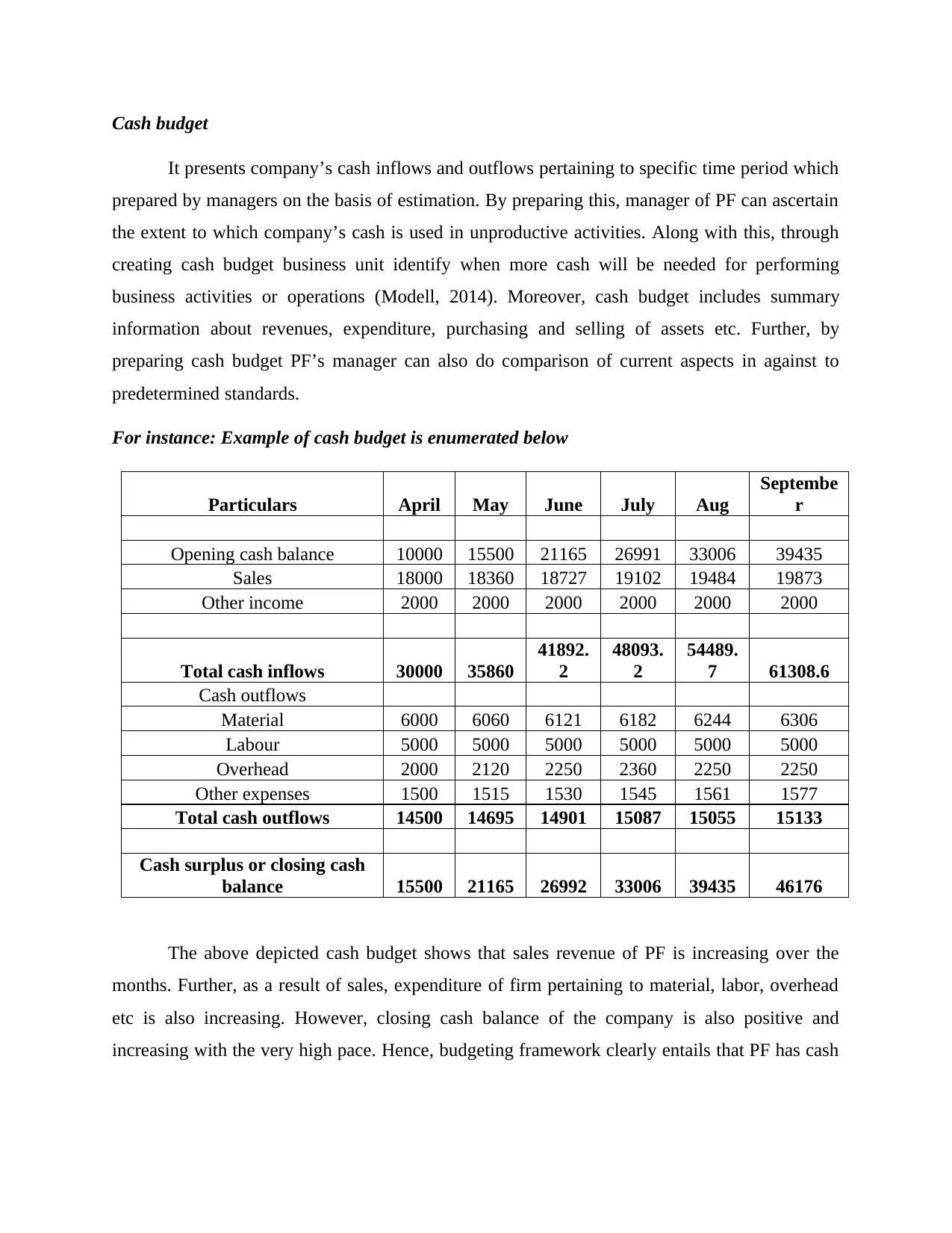
Cash budget
It presents company’s cash inflows and outflows pertaining to specific time period which
prepared by managers on the basis of estimation. By preparing this, manager of PF can ascertain
the extent to which company’s cash is used in unproductive activities. Along with this, through
creating cash budget business unit identify when more cash will be needed for performing
business activities or operations (Modell, 2014). Moreover, cash budget includes summary
information about revenues, expenditure, purchasing and selling of assets etc. Further, by
preparing cash budget PF’s manager can also do comparison of current aspects in against to
predetermined standards.
For instance: Example of cash budget is enumerated below
Particulars April May June July Aug
Septembe
r
Opening cash balance 10000 15500 21165 26991 33006 39435
Sales 18000 18360 18727 19102 19484 19873
Other income 2000 2000 2000 2000 2000 2000
Total cash inflows 30000 35860
41892.
2
48093.
2
54489.
7 61308.6
Cash outflows
Material 6000 6060 6121 6182 6244 6306
Labour 5000 5000 5000 5000 5000 5000
Overhead 2000 2120 2250 2360 2250 2250
Other expenses 1500 1515 1530 1545 1561 1577
Total cash outflows 14500 14695 14901 15087 15055 15133
Cash surplus or closing cash
balance 15500 21165 26992 33006 39435 46176
The above depicted cash budget shows that sales revenue of PF is increasing over the
months. Further, as a result of sales, expenditure of firm pertaining to material, labor, overhead
etc is also increasing. However, closing cash balance of the company is also positive and
increasing with the very high pace. Hence, budgeting framework clearly entails that PF has cash
It presents company’s cash inflows and outflows pertaining to specific time period which
prepared by managers on the basis of estimation. By preparing this, manager of PF can ascertain
the extent to which company’s cash is used in unproductive activities. Along with this, through
creating cash budget business unit identify when more cash will be needed for performing
business activities or operations (Modell, 2014). Moreover, cash budget includes summary
information about revenues, expenditure, purchasing and selling of assets etc. Further, by
preparing cash budget PF’s manager can also do comparison of current aspects in against to
predetermined standards.
For instance: Example of cash budget is enumerated below
Particulars April May June July Aug
Septembe
r
Opening cash balance 10000 15500 21165 26991 33006 39435
Sales 18000 18360 18727 19102 19484 19873
Other income 2000 2000 2000 2000 2000 2000
Total cash inflows 30000 35860
41892.
2
48093.
2
54489.
7 61308.6
Cash outflows
Material 6000 6060 6121 6182 6244 6306
Labour 5000 5000 5000 5000 5000 5000
Overhead 2000 2120 2250 2360 2250 2250
Other expenses 1500 1515 1530 1545 1561 1577
Total cash outflows 14500 14695 14901 15087 15055 15133
Cash surplus or closing cash
balance 15500 21165 26992 33006 39435 46176
The above depicted cash budget shows that sales revenue of PF is increasing over the
months. Further, as a result of sales, expenditure of firm pertaining to material, labor, overhead
etc is also increasing. However, closing cash balance of the company is also positive and
increasing with the very high pace. Hence, budgeting framework clearly entails that PF has cash
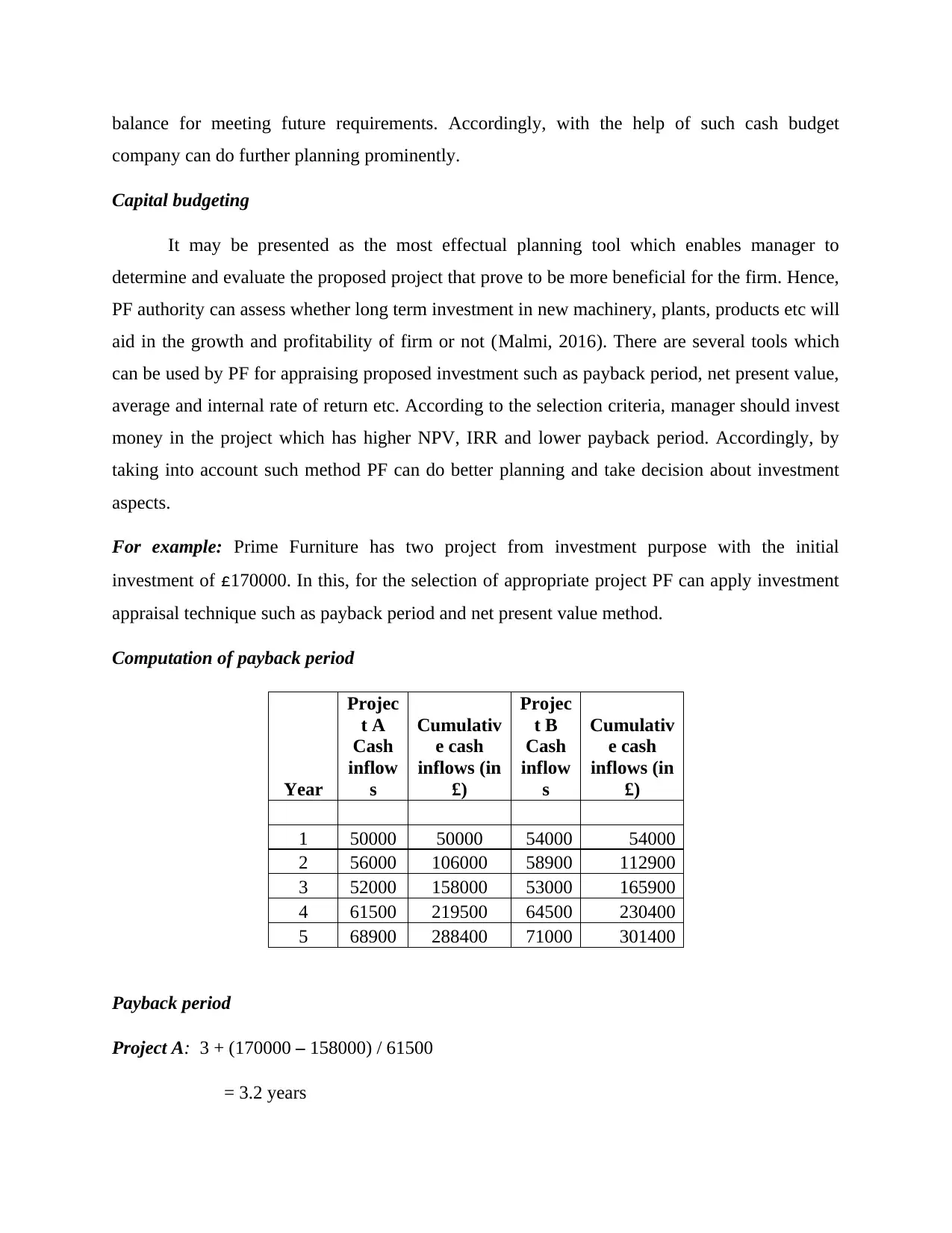
balance for meeting future requirements. Accordingly, with the help of such cash budget
company can do further planning prominently.
Capital budgeting
It may be presented as the most effectual planning tool which enables manager to
determine and evaluate the proposed project that prove to be more beneficial for the firm. Hence,
PF authority can assess whether long term investment in new machinery, plants, products etc will
aid in the growth and profitability of firm or not (Malmi, 2016). There are several tools which
can be used by PF for appraising proposed investment such as payback period, net present value,
average and internal rate of return etc. According to the selection criteria, manager should invest
money in the project which has higher NPV, IRR and lower payback period. Accordingly, by
taking into account such method PF can do better planning and take decision about investment
aspects.
For example: Prime Furniture has two project from investment purpose with the initial
investment of £170000. In this, for the selection of appropriate project PF can apply investment
appraisal technique such as payback period and net present value method.
Computation of payback period
Year
Projec
t A
Cash
inflow
s
Cumulativ
e cash
inflows (in
£)
Projec
t B
Cash
inflow
s
Cumulativ
e cash
inflows (in
£)
1 50000 50000 54000 54000
2 56000 106000 58900 112900
3 52000 158000 53000 165900
4 61500 219500 64500 230400
5 68900 288400 71000 301400
Payback period
Project A: 3 + (170000 – 158000) / 61500
= 3.2 years
company can do further planning prominently.
Capital budgeting
It may be presented as the most effectual planning tool which enables manager to
determine and evaluate the proposed project that prove to be more beneficial for the firm. Hence,
PF authority can assess whether long term investment in new machinery, plants, products etc will
aid in the growth and profitability of firm or not (Malmi, 2016). There are several tools which
can be used by PF for appraising proposed investment such as payback period, net present value,
average and internal rate of return etc. According to the selection criteria, manager should invest
money in the project which has higher NPV, IRR and lower payback period. Accordingly, by
taking into account such method PF can do better planning and take decision about investment
aspects.
For example: Prime Furniture has two project from investment purpose with the initial
investment of £170000. In this, for the selection of appropriate project PF can apply investment
appraisal technique such as payback period and net present value method.
Computation of payback period
Year
Projec
t A
Cash
inflow
s
Cumulativ
e cash
inflows (in
£)
Projec
t B
Cash
inflow
s
Cumulativ
e cash
inflows (in
£)
1 50000 50000 54000 54000
2 56000 106000 58900 112900
3 52000 158000 53000 165900
4 61500 219500 64500 230400
5 68900 288400 71000 301400
Payback period
Project A: 3 + (170000 – 158000) / 61500
= 3.2 years
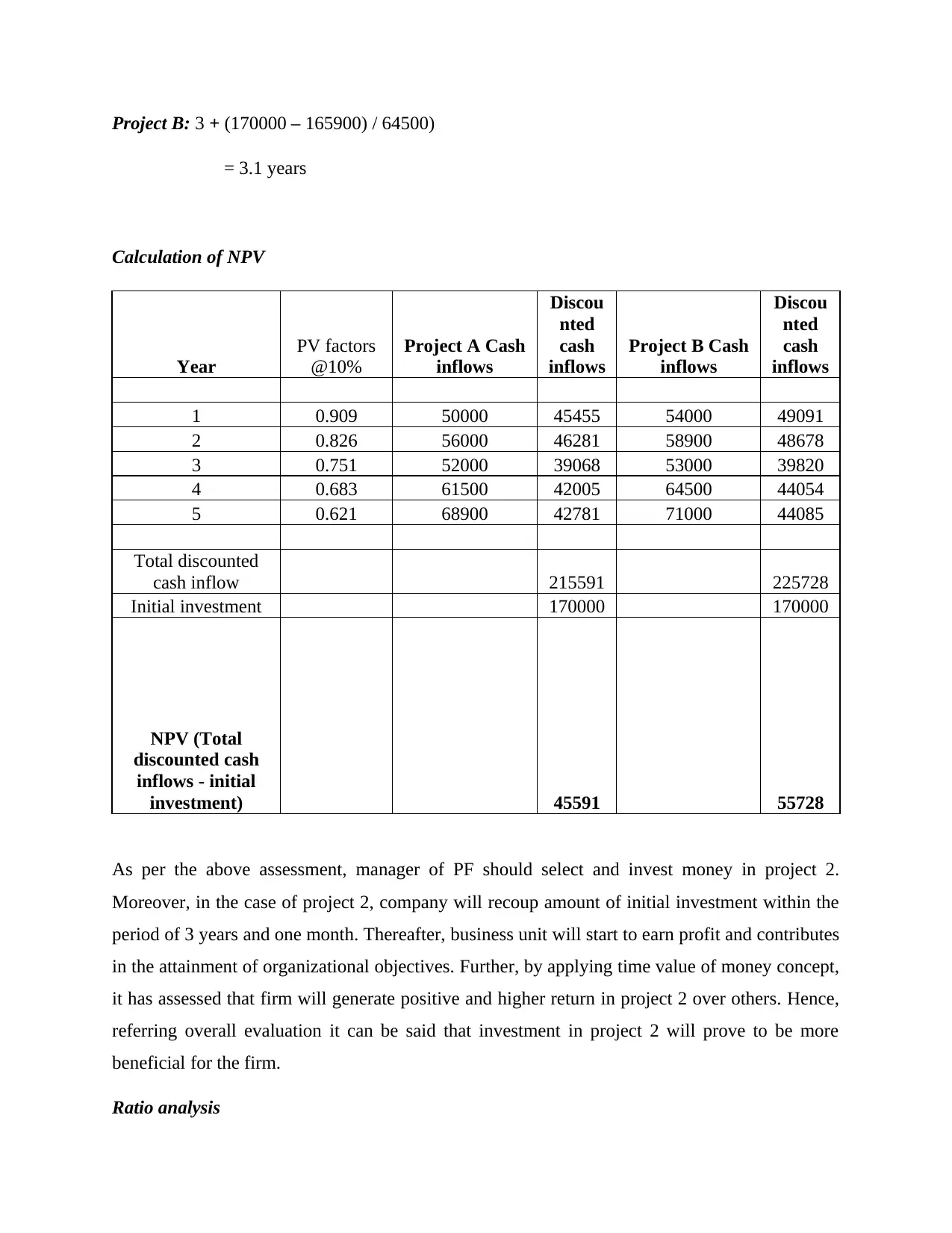
Project B: 3 + (170000 – 165900) / 64500)
= 3.1 years
Calculation of NPV
Year
PV factors
@10%
Project A Cash
inflows
Discou
nted
cash
inflows
Project B Cash
inflows
Discou
nted
cash
inflows
1 0.909 50000 45455 54000 49091
2 0.826 56000 46281 58900 48678
3 0.751 52000 39068 53000 39820
4 0.683 61500 42005 64500 44054
5 0.621 68900 42781 71000 44085
Total discounted
cash inflow 215591 225728
Initial investment 170000 170000
NPV (Total
discounted cash
inflows - initial
investment) 45591 55728
As per the above assessment, manager of PF should select and invest money in project 2.
Moreover, in the case of project 2, company will recoup amount of initial investment within the
period of 3 years and one month. Thereafter, business unit will start to earn profit and contributes
in the attainment of organizational objectives. Further, by applying time value of money concept,
it has assessed that firm will generate positive and higher return in project 2 over others. Hence,
referring overall evaluation it can be said that investment in project 2 will prove to be more
beneficial for the firm.
Ratio analysis
= 3.1 years
Calculation of NPV
Year
PV factors
@10%
Project A Cash
inflows
Discou
nted
cash
inflows
Project B Cash
inflows
Discou
nted
cash
inflows
1 0.909 50000 45455 54000 49091
2 0.826 56000 46281 58900 48678
3 0.751 52000 39068 53000 39820
4 0.683 61500 42005 64500 44054
5 0.621 68900 42781 71000 44085
Total discounted
cash inflow 215591 225728
Initial investment 170000 170000
NPV (Total
discounted cash
inflows - initial
investment) 45591 55728
As per the above assessment, manager of PF should select and invest money in project 2.
Moreover, in the case of project 2, company will recoup amount of initial investment within the
period of 3 years and one month. Thereafter, business unit will start to earn profit and contributes
in the attainment of organizational objectives. Further, by applying time value of money concept,
it has assessed that firm will generate positive and higher return in project 2 over others. Hence,
referring overall evaluation it can be said that investment in project 2 will prove to be more
beneficial for the firm.
Ratio analysis
Paraphrase This Document
Need a fresh take? Get an instant paraphrase of this document with our AI Paraphraser
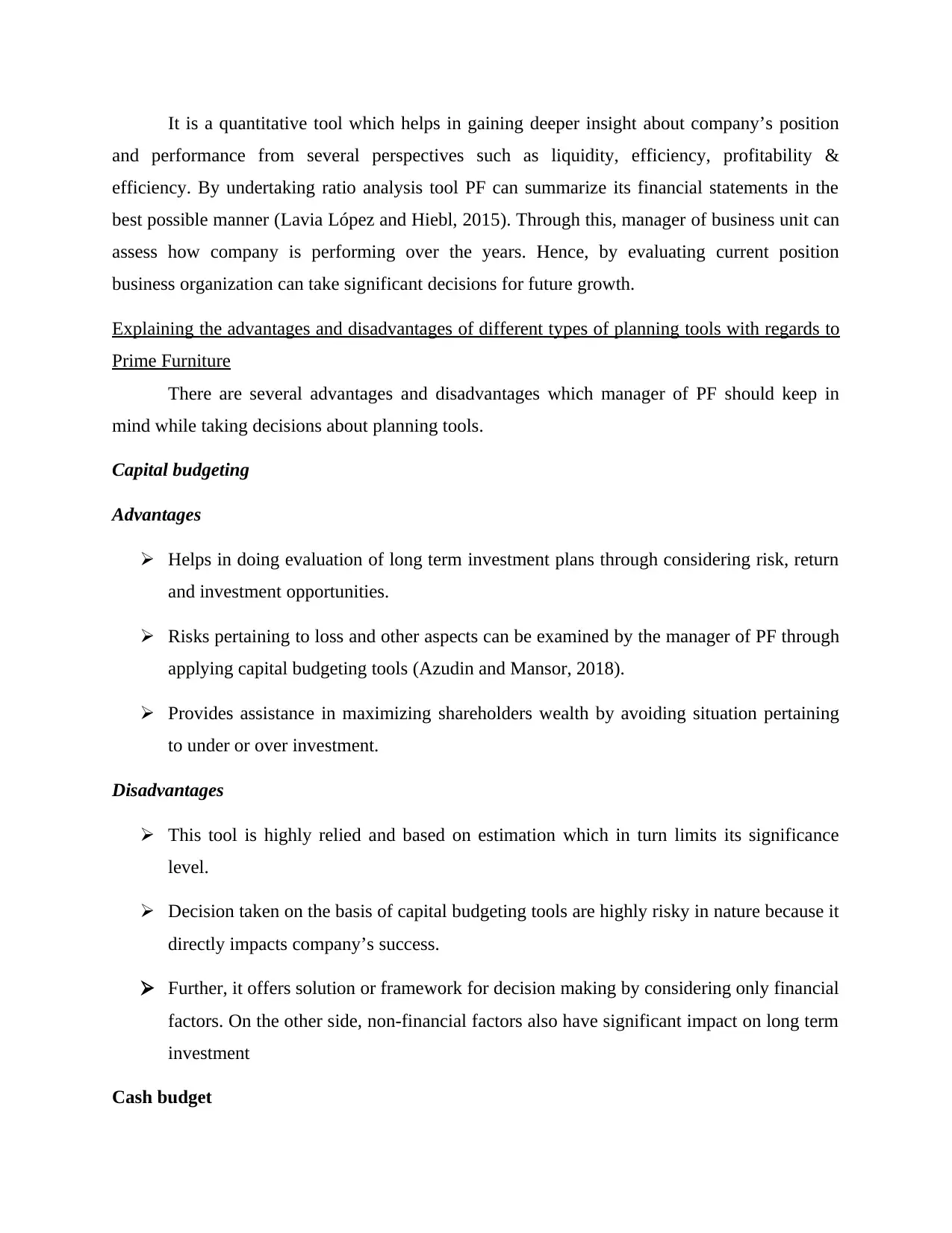
It is a quantitative tool which helps in gaining deeper insight about company’s position
and performance from several perspectives such as liquidity, efficiency, profitability &
efficiency. By undertaking ratio analysis tool PF can summarize its financial statements in the
best possible manner (Lavia López and Hiebl, 2015). Through this, manager of business unit can
assess how company is performing over the years. Hence, by evaluating current position
business organization can take significant decisions for future growth.
Explaining the advantages and disadvantages of different types of planning tools with regards to
Prime Furniture
There are several advantages and disadvantages which manager of PF should keep in
mind while taking decisions about planning tools.
Capital budgeting
Advantages
Helps in doing evaluation of long term investment plans through considering risk, return
and investment opportunities.
Risks pertaining to loss and other aspects can be examined by the manager of PF through
applying capital budgeting tools (Azudin and Mansor, 2018).
Provides assistance in maximizing shareholders wealth by avoiding situation pertaining
to under or over investment.
Disadvantages
This tool is highly relied and based on estimation which in turn limits its significance
level.
Decision taken on the basis of capital budgeting tools are highly risky in nature because it
directly impacts company’s success.
Further, it offers solution or framework for decision making by considering only financial
factors. On the other side, non-financial factors also have significant impact on long term
investment
Cash budget
and performance from several perspectives such as liquidity, efficiency, profitability &
efficiency. By undertaking ratio analysis tool PF can summarize its financial statements in the
best possible manner (Lavia López and Hiebl, 2015). Through this, manager of business unit can
assess how company is performing over the years. Hence, by evaluating current position
business organization can take significant decisions for future growth.
Explaining the advantages and disadvantages of different types of planning tools with regards to
Prime Furniture
There are several advantages and disadvantages which manager of PF should keep in
mind while taking decisions about planning tools.
Capital budgeting
Advantages
Helps in doing evaluation of long term investment plans through considering risk, return
and investment opportunities.
Risks pertaining to loss and other aspects can be examined by the manager of PF through
applying capital budgeting tools (Azudin and Mansor, 2018).
Provides assistance in maximizing shareholders wealth by avoiding situation pertaining
to under or over investment.
Disadvantages
This tool is highly relied and based on estimation which in turn limits its significance
level.
Decision taken on the basis of capital budgeting tools are highly risky in nature because it
directly impacts company’s success.
Further, it offers solution or framework for decision making by considering only financial
factors. On the other side, non-financial factors also have significant impact on long term
investment
Cash budget
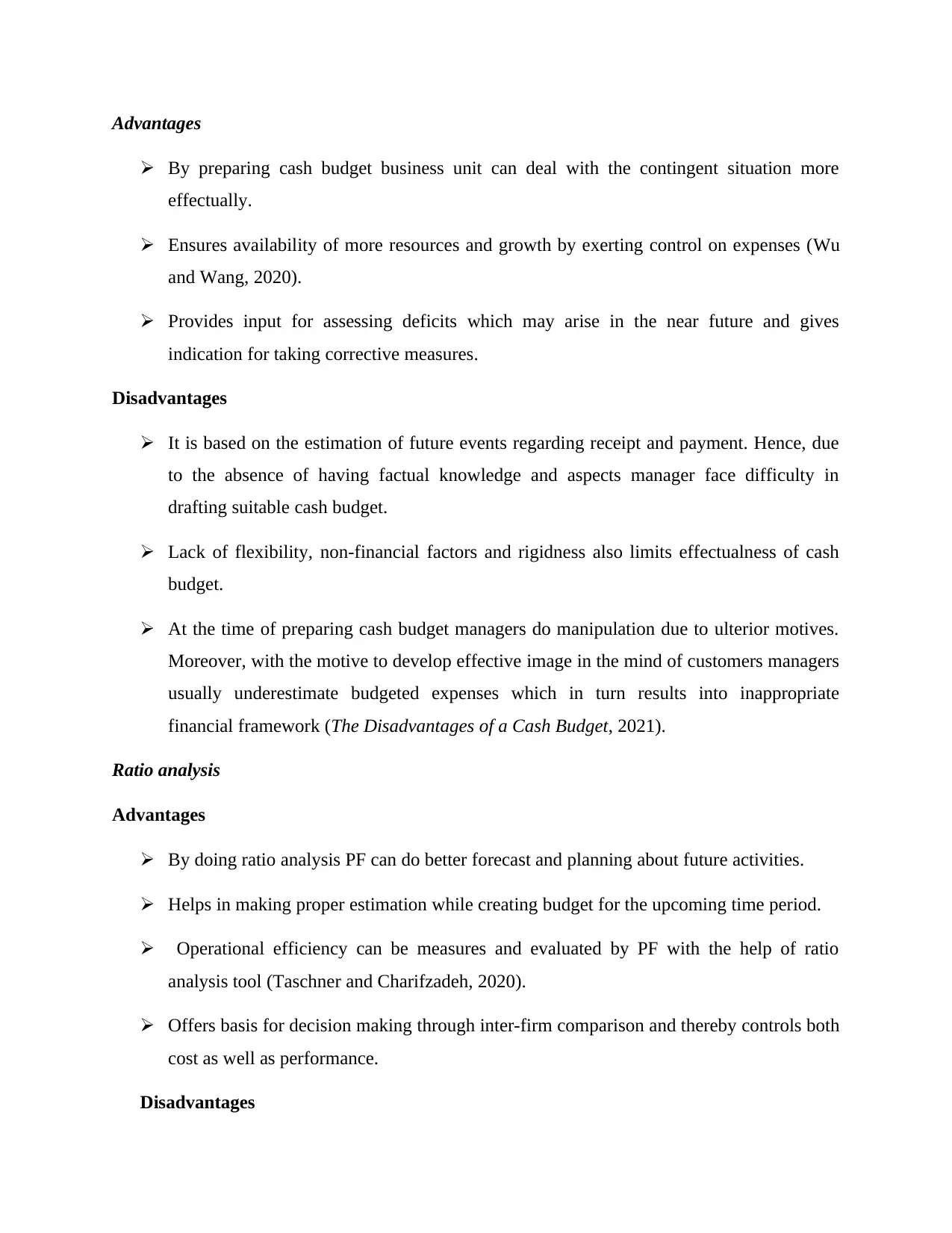
Advantages
By preparing cash budget business unit can deal with the contingent situation more
effectually.
Ensures availability of more resources and growth by exerting control on expenses (Wu
and Wang, 2020).
Provides input for assessing deficits which may arise in the near future and gives
indication for taking corrective measures.
Disadvantages
It is based on the estimation of future events regarding receipt and payment. Hence, due
to the absence of having factual knowledge and aspects manager face difficulty in
drafting suitable cash budget.
Lack of flexibility, non-financial factors and rigidness also limits effectualness of cash
budget.
At the time of preparing cash budget managers do manipulation due to ulterior motives.
Moreover, with the motive to develop effective image in the mind of customers managers
usually underestimate budgeted expenses which in turn results into inappropriate
financial framework (The Disadvantages of a Cash Budget, 2021).
Ratio analysis
Advantages
By doing ratio analysis PF can do better forecast and planning about future activities.
Helps in making proper estimation while creating budget for the upcoming time period.
Operational efficiency can be measures and evaluated by PF with the help of ratio
analysis tool (Taschner and Charifzadeh, 2020).
Offers basis for decision making through inter-firm comparison and thereby controls both
cost as well as performance.
Disadvantages
By preparing cash budget business unit can deal with the contingent situation more
effectually.
Ensures availability of more resources and growth by exerting control on expenses (Wu
and Wang, 2020).
Provides input for assessing deficits which may arise in the near future and gives
indication for taking corrective measures.
Disadvantages
It is based on the estimation of future events regarding receipt and payment. Hence, due
to the absence of having factual knowledge and aspects manager face difficulty in
drafting suitable cash budget.
Lack of flexibility, non-financial factors and rigidness also limits effectualness of cash
budget.
At the time of preparing cash budget managers do manipulation due to ulterior motives.
Moreover, with the motive to develop effective image in the mind of customers managers
usually underestimate budgeted expenses which in turn results into inappropriate
financial framework (The Disadvantages of a Cash Budget, 2021).
Ratio analysis
Advantages
By doing ratio analysis PF can do better forecast and planning about future activities.
Helps in making proper estimation while creating budget for the upcoming time period.
Operational efficiency can be measures and evaluated by PF with the help of ratio
analysis tool (Taschner and Charifzadeh, 2020).
Offers basis for decision making through inter-firm comparison and thereby controls both
cost as well as performance.
Disadvantages
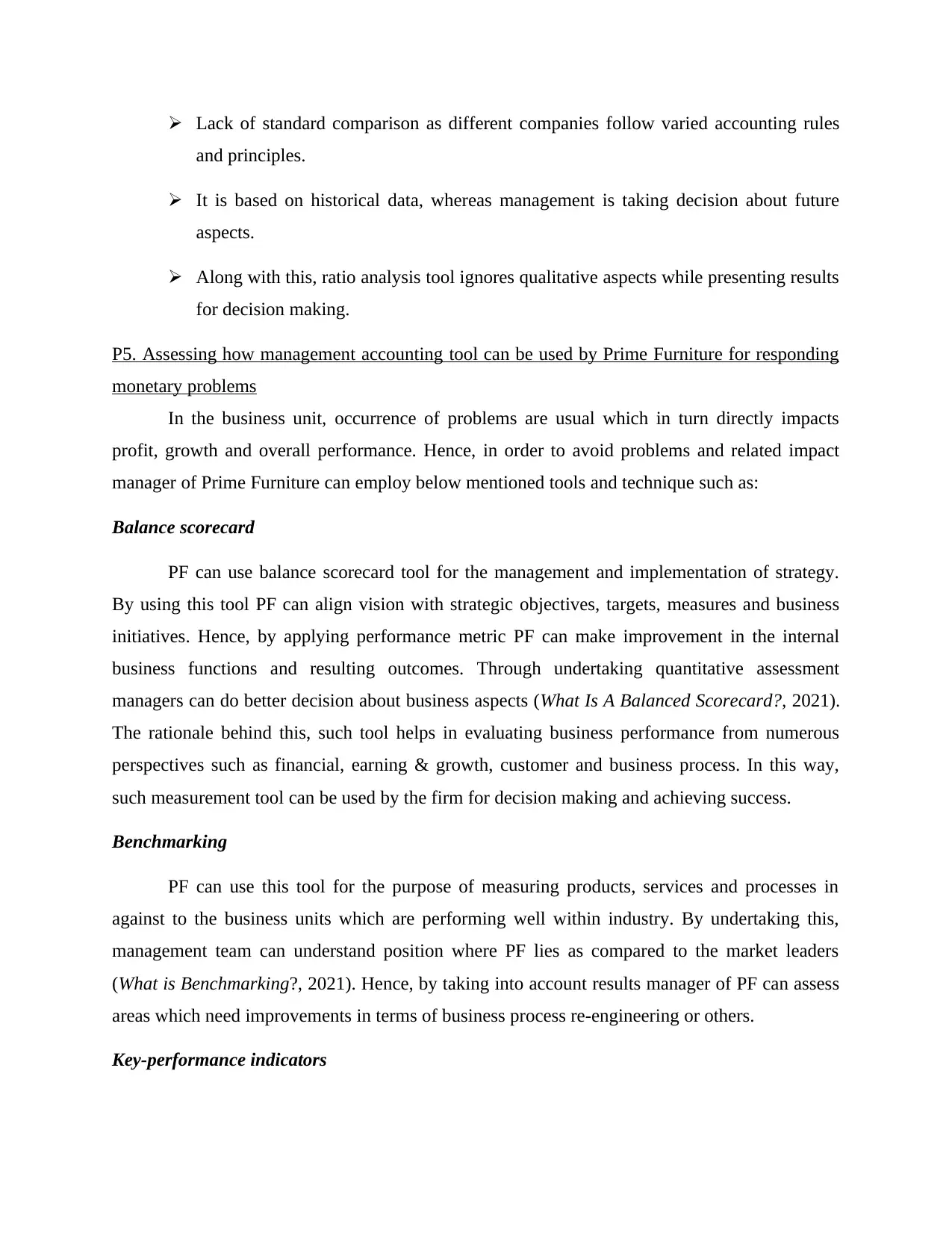
Lack of standard comparison as different companies follow varied accounting rules
and principles.
It is based on historical data, whereas management is taking decision about future
aspects.
Along with this, ratio analysis tool ignores qualitative aspects while presenting results
for decision making.
P5. Assessing how management accounting tool can be used by Prime Furniture for responding
monetary problems
In the business unit, occurrence of problems are usual which in turn directly impacts
profit, growth and overall performance. Hence, in order to avoid problems and related impact
manager of Prime Furniture can employ below mentioned tools and technique such as:
Balance scorecard
PF can use balance scorecard tool for the management and implementation of strategy.
By using this tool PF can align vision with strategic objectives, targets, measures and business
initiatives. Hence, by applying performance metric PF can make improvement in the internal
business functions and resulting outcomes. Through undertaking quantitative assessment
managers can do better decision about business aspects (What Is A Balanced Scorecard?, 2021).
The rationale behind this, such tool helps in evaluating business performance from numerous
perspectives such as financial, earning & growth, customer and business process. In this way,
such measurement tool can be used by the firm for decision making and achieving success.
Benchmarking
PF can use this tool for the purpose of measuring products, services and processes in
against to the business units which are performing well within industry. By undertaking this,
management team can understand position where PF lies as compared to the market leaders
(What is Benchmarking?, 2021). Hence, by taking into account results manager of PF can assess
areas which need improvements in terms of business process re-engineering or others.
Key-performance indicators
and principles.
It is based on historical data, whereas management is taking decision about future
aspects.
Along with this, ratio analysis tool ignores qualitative aspects while presenting results
for decision making.
P5. Assessing how management accounting tool can be used by Prime Furniture for responding
monetary problems
In the business unit, occurrence of problems are usual which in turn directly impacts
profit, growth and overall performance. Hence, in order to avoid problems and related impact
manager of Prime Furniture can employ below mentioned tools and technique such as:
Balance scorecard
PF can use balance scorecard tool for the management and implementation of strategy.
By using this tool PF can align vision with strategic objectives, targets, measures and business
initiatives. Hence, by applying performance metric PF can make improvement in the internal
business functions and resulting outcomes. Through undertaking quantitative assessment
managers can do better decision about business aspects (What Is A Balanced Scorecard?, 2021).
The rationale behind this, such tool helps in evaluating business performance from numerous
perspectives such as financial, earning & growth, customer and business process. In this way,
such measurement tool can be used by the firm for decision making and achieving success.
Benchmarking
PF can use this tool for the purpose of measuring products, services and processes in
against to the business units which are performing well within industry. By undertaking this,
management team can understand position where PF lies as compared to the market leaders
(What is Benchmarking?, 2021). Hence, by taking into account results manager of PF can assess
areas which need improvements in terms of business process re-engineering or others.
Key-performance indicators
Secure Best Marks with AI Grader
Need help grading? Try our AI Grader for instant feedback on your assignments.
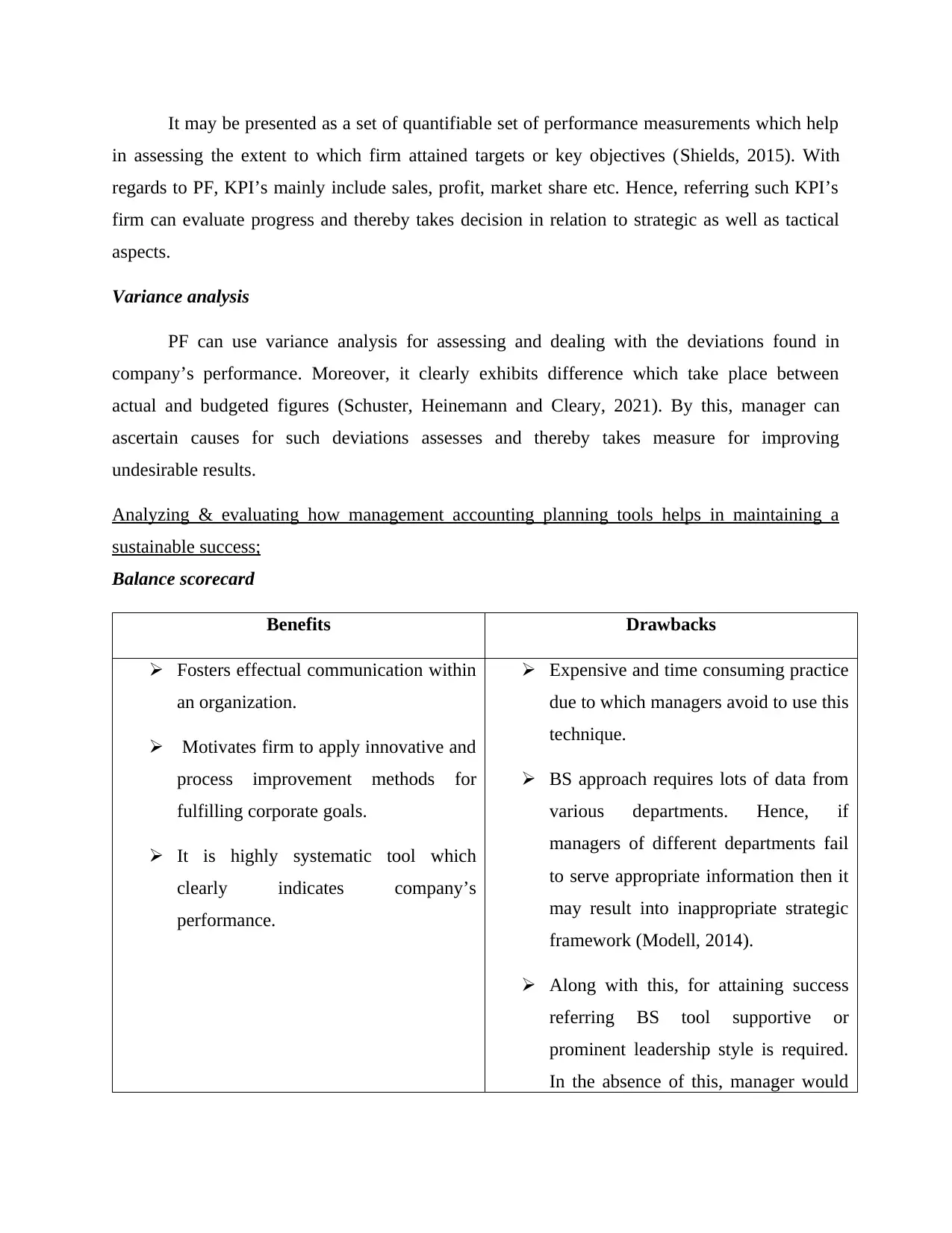
It may be presented as a set of quantifiable set of performance measurements which help
in assessing the extent to which firm attained targets or key objectives (Shields, 2015). With
regards to PF, KPI’s mainly include sales, profit, market share etc. Hence, referring such KPI’s
firm can evaluate progress and thereby takes decision in relation to strategic as well as tactical
aspects.
Variance analysis
PF can use variance analysis for assessing and dealing with the deviations found in
company’s performance. Moreover, it clearly exhibits difference which take place between
actual and budgeted figures (Schuster, Heinemann and Cleary, 2021). By this, manager can
ascertain causes for such deviations assesses and thereby takes measure for improving
undesirable results.
Analyzing & evaluating how management accounting planning tools helps in maintaining a
sustainable success;
Balance scorecard
Benefits Drawbacks
Fosters effectual communication within
an organization.
Motivates firm to apply innovative and
process improvement methods for
fulfilling corporate goals.
It is highly systematic tool which
clearly indicates company’s
performance.
Expensive and time consuming practice
due to which managers avoid to use this
technique.
BS approach requires lots of data from
various departments. Hence, if
managers of different departments fail
to serve appropriate information then it
may result into inappropriate strategic
framework (Modell, 2014).
Along with this, for attaining success
referring BS tool supportive or
prominent leadership style is required.
In the absence of this, manager would
in assessing the extent to which firm attained targets or key objectives (Shields, 2015). With
regards to PF, KPI’s mainly include sales, profit, market share etc. Hence, referring such KPI’s
firm can evaluate progress and thereby takes decision in relation to strategic as well as tactical
aspects.
Variance analysis
PF can use variance analysis for assessing and dealing with the deviations found in
company’s performance. Moreover, it clearly exhibits difference which take place between
actual and budgeted figures (Schuster, Heinemann and Cleary, 2021). By this, manager can
ascertain causes for such deviations assesses and thereby takes measure for improving
undesirable results.
Analyzing & evaluating how management accounting planning tools helps in maintaining a
sustainable success;
Balance scorecard
Benefits Drawbacks
Fosters effectual communication within
an organization.
Motivates firm to apply innovative and
process improvement methods for
fulfilling corporate goals.
It is highly systematic tool which
clearly indicates company’s
performance.
Expensive and time consuming practice
due to which managers avoid to use this
technique.
BS approach requires lots of data from
various departments. Hence, if
managers of different departments fail
to serve appropriate information then it
may result into inappropriate strategic
framework (Modell, 2014).
Along with this, for attaining success
referring BS tool supportive or
prominent leadership style is required.
In the absence of this, manager would
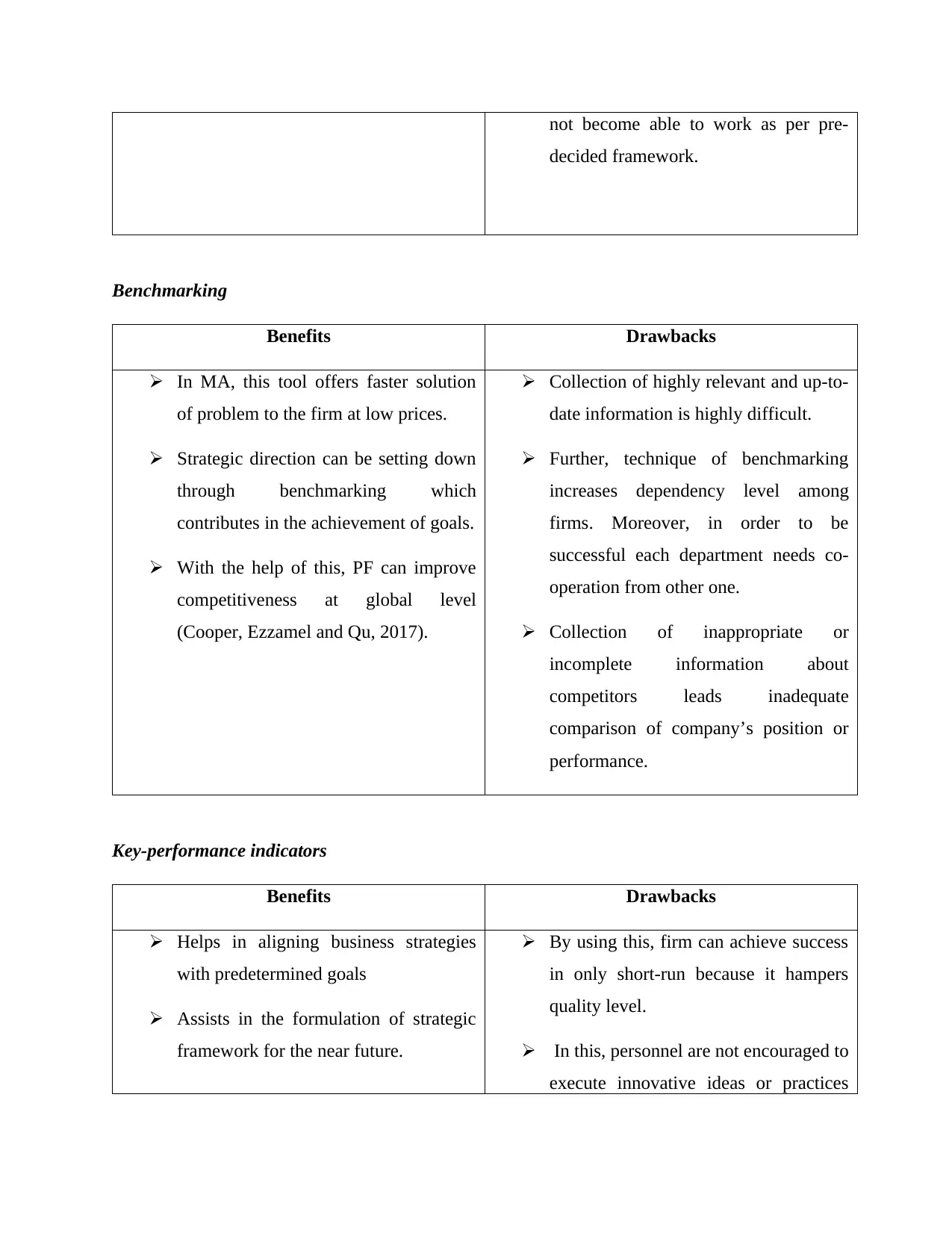
not become able to work as per pre-
decided framework.
Benchmarking
Benefits Drawbacks
In MA, this tool offers faster solution
of problem to the firm at low prices.
Strategic direction can be setting down
through benchmarking which
contributes in the achievement of goals.
With the help of this, PF can improve
competitiveness at global level
(Cooper, Ezzamel and Qu, 2017).
Collection of highly relevant and up-to-
date information is highly difficult.
Further, technique of benchmarking
increases dependency level among
firms. Moreover, in order to be
successful each department needs co-
operation from other one.
Collection of inappropriate or
incomplete information about
competitors leads inadequate
comparison of company’s position or
performance.
Key-performance indicators
Benefits Drawbacks
Helps in aligning business strategies
with predetermined goals
Assists in the formulation of strategic
framework for the near future.
By using this, firm can achieve success
in only short-run because it hampers
quality level.
In this, personnel are not encouraged to
execute innovative ideas or practices
decided framework.
Benchmarking
Benefits Drawbacks
In MA, this tool offers faster solution
of problem to the firm at low prices.
Strategic direction can be setting down
through benchmarking which
contributes in the achievement of goals.
With the help of this, PF can improve
competitiveness at global level
(Cooper, Ezzamel and Qu, 2017).
Collection of highly relevant and up-to-
date information is highly difficult.
Further, technique of benchmarking
increases dependency level among
firms. Moreover, in order to be
successful each department needs co-
operation from other one.
Collection of inappropriate or
incomplete information about
competitors leads inadequate
comparison of company’s position or
performance.
Key-performance indicators
Benefits Drawbacks
Helps in aligning business strategies
with predetermined goals
Assists in the formulation of strategic
framework for the near future.
By using this, firm can achieve success
in only short-run because it hampers
quality level.
In this, personnel are not encouraged to
execute innovative ideas or practices
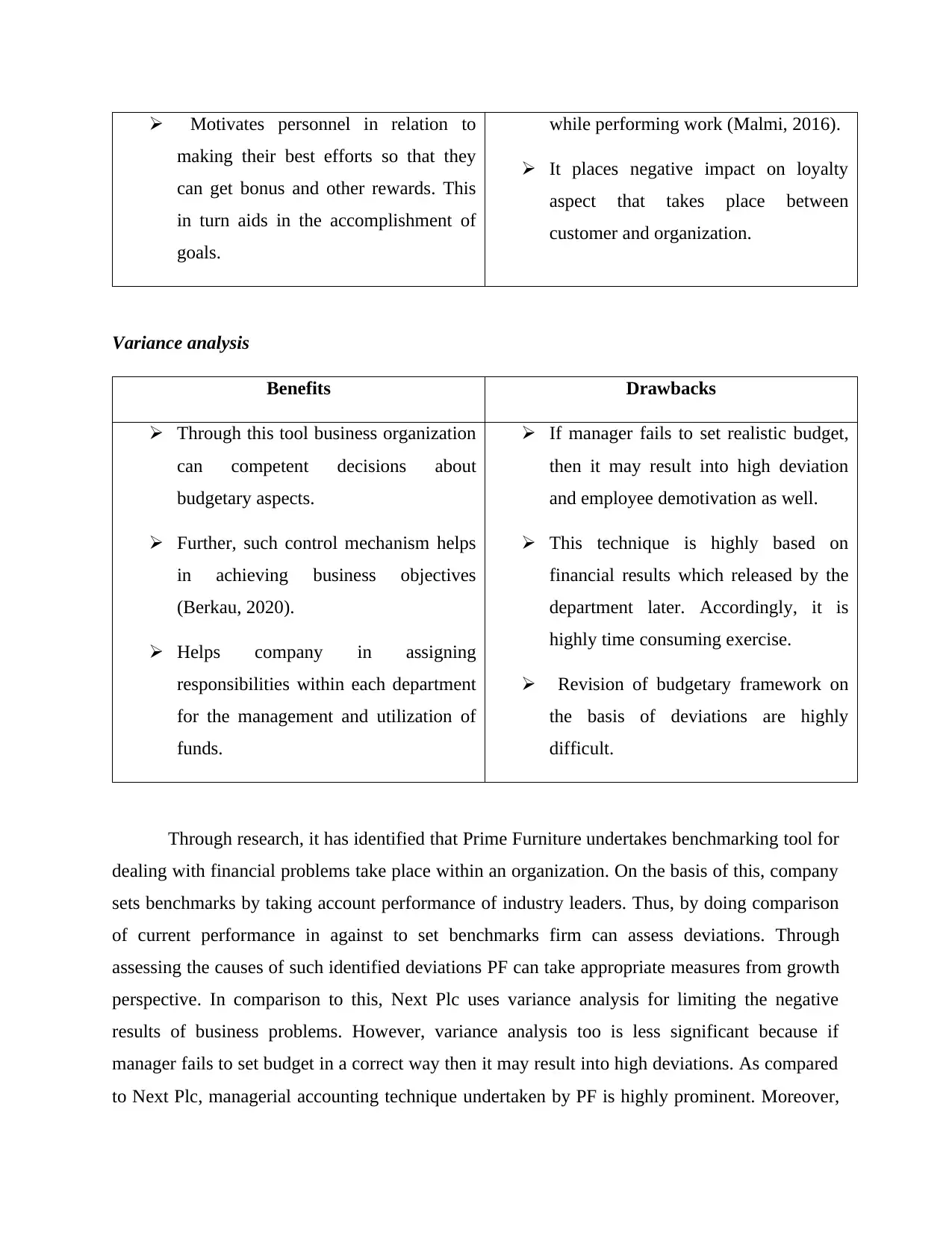
Motivates personnel in relation to
making their best efforts so that they
can get bonus and other rewards. This
in turn aids in the accomplishment of
goals.
while performing work (Malmi, 2016).
It places negative impact on loyalty
aspect that takes place between
customer and organization.
Variance analysis
Benefits Drawbacks
Through this tool business organization
can competent decisions about
budgetary aspects.
Further, such control mechanism helps
in achieving business objectives
(Berkau, 2020).
Helps company in assigning
responsibilities within each department
for the management and utilization of
funds.
If manager fails to set realistic budget,
then it may result into high deviation
and employee demotivation as well.
This technique is highly based on
financial results which released by the
department later. Accordingly, it is
highly time consuming exercise.
Revision of budgetary framework on
the basis of deviations are highly
difficult.
Through research, it has identified that Prime Furniture undertakes benchmarking tool for
dealing with financial problems take place within an organization. On the basis of this, company
sets benchmarks by taking account performance of industry leaders. Thus, by doing comparison
of current performance in against to set benchmarks firm can assess deviations. Through
assessing the causes of such identified deviations PF can take appropriate measures from growth
perspective. In comparison to this, Next Plc uses variance analysis for limiting the negative
results of business problems. However, variance analysis too is less significant because if
manager fails to set budget in a correct way then it may result into high deviations. As compared
to Next Plc, managerial accounting technique undertaken by PF is highly prominent. Moreover,
making their best efforts so that they
can get bonus and other rewards. This
in turn aids in the accomplishment of
goals.
while performing work (Malmi, 2016).
It places negative impact on loyalty
aspect that takes place between
customer and organization.
Variance analysis
Benefits Drawbacks
Through this tool business organization
can competent decisions about
budgetary aspects.
Further, such control mechanism helps
in achieving business objectives
(Berkau, 2020).
Helps company in assigning
responsibilities within each department
for the management and utilization of
funds.
If manager fails to set realistic budget,
then it may result into high deviation
and employee demotivation as well.
This technique is highly based on
financial results which released by the
department later. Accordingly, it is
highly time consuming exercise.
Revision of budgetary framework on
the basis of deviations are highly
difficult.
Through research, it has identified that Prime Furniture undertakes benchmarking tool for
dealing with financial problems take place within an organization. On the basis of this, company
sets benchmarks by taking account performance of industry leaders. Thus, by doing comparison
of current performance in against to set benchmarks firm can assess deviations. Through
assessing the causes of such identified deviations PF can take appropriate measures from growth
perspective. In comparison to this, Next Plc uses variance analysis for limiting the negative
results of business problems. However, variance analysis too is less significant because if
manager fails to set budget in a correct way then it may result into high deviations. As compared
to Next Plc, managerial accounting technique undertaken by PF is highly prominent. Moreover,
Paraphrase This Document
Need a fresh take? Get an instant paraphrase of this document with our AI Paraphraser
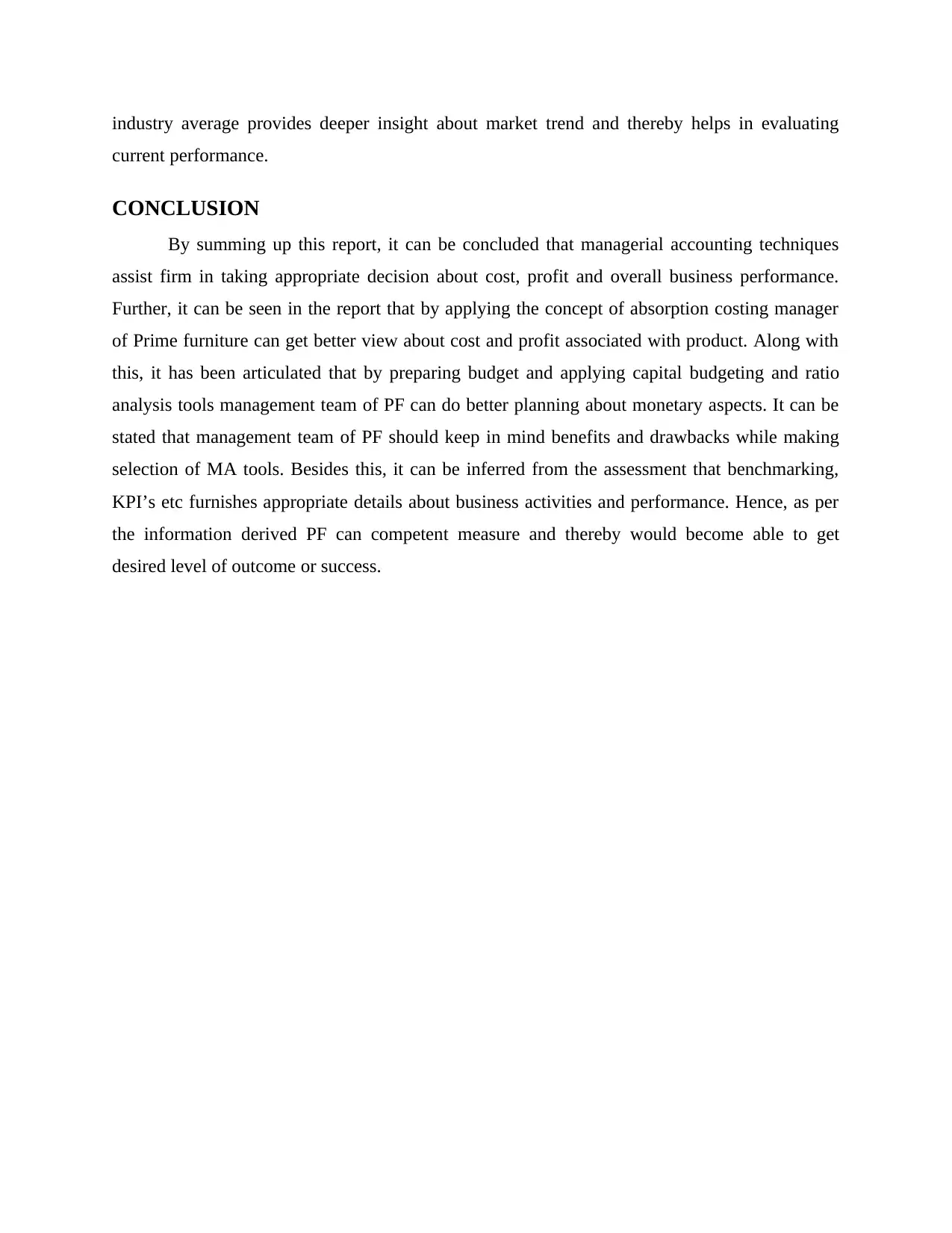
industry average provides deeper insight about market trend and thereby helps in evaluating
current performance.
CONCLUSION
By summing up this report, it can be concluded that managerial accounting techniques
assist firm in taking appropriate decision about cost, profit and overall business performance.
Further, it can be seen in the report that by applying the concept of absorption costing manager
of Prime furniture can get better view about cost and profit associated with product. Along with
this, it has been articulated that by preparing budget and applying capital budgeting and ratio
analysis tools management team of PF can do better planning about monetary aspects. It can be
stated that management team of PF should keep in mind benefits and drawbacks while making
selection of MA tools. Besides this, it can be inferred from the assessment that benchmarking,
KPI’s etc furnishes appropriate details about business activities and performance. Hence, as per
the information derived PF can competent measure and thereby would become able to get
desired level of outcome or success.
current performance.
CONCLUSION
By summing up this report, it can be concluded that managerial accounting techniques
assist firm in taking appropriate decision about cost, profit and overall business performance.
Further, it can be seen in the report that by applying the concept of absorption costing manager
of Prime furniture can get better view about cost and profit associated with product. Along with
this, it has been articulated that by preparing budget and applying capital budgeting and ratio
analysis tools management team of PF can do better planning about monetary aspects. It can be
stated that management team of PF should keep in mind benefits and drawbacks while making
selection of MA tools. Besides this, it can be inferred from the assessment that benchmarking,
KPI’s etc furnishes appropriate details about business activities and performance. Hence, as per
the information derived PF can competent measure and thereby would become able to get
desired level of outcome or success.
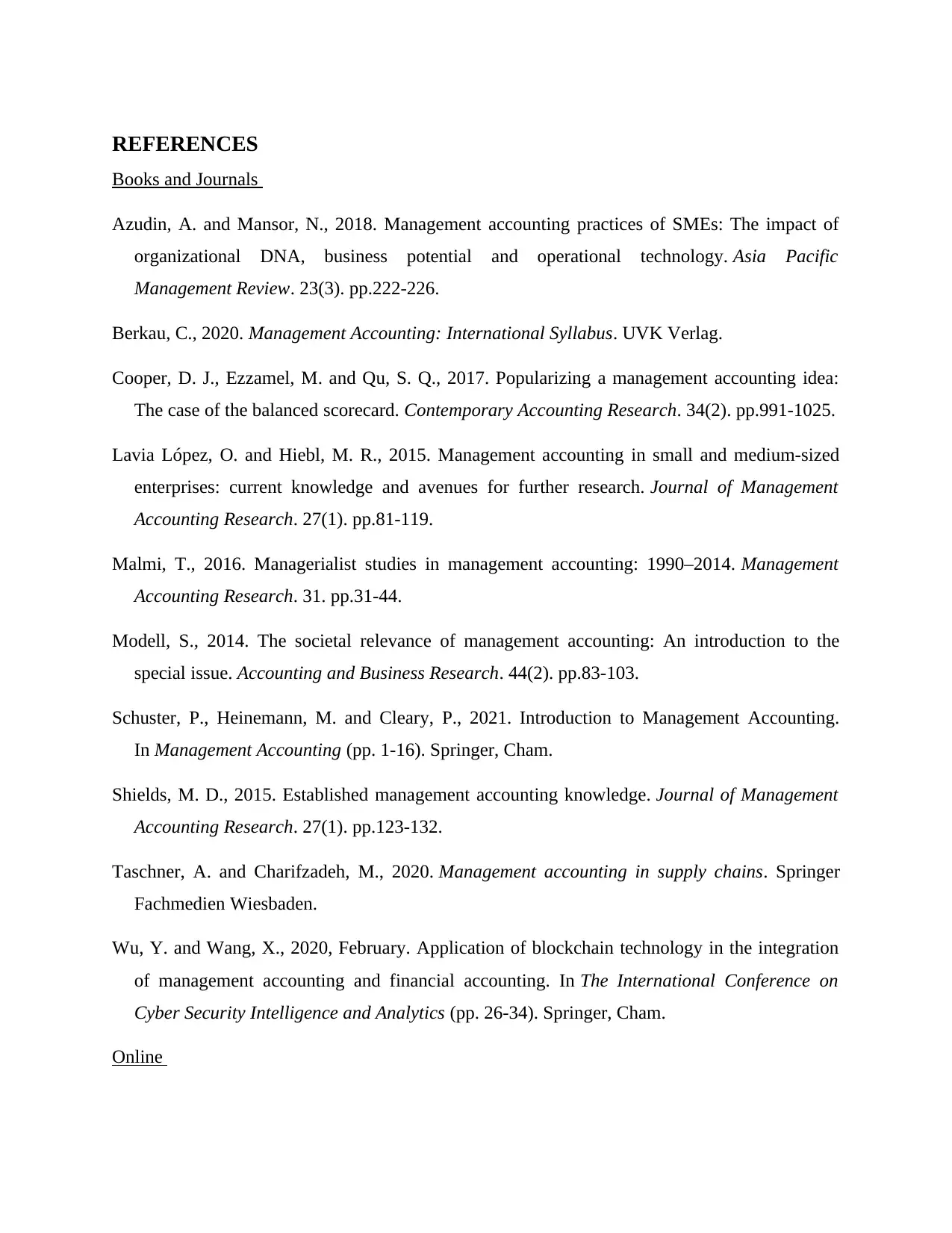
REFERENCES
Books and Journals
Azudin, A. and Mansor, N., 2018. Management accounting practices of SMEs: The impact of
organizational DNA, business potential and operational technology. Asia Pacific
Management Review. 23(3). pp.222-226.
Berkau, C., 2020. Management Accounting: International Syllabus. UVK Verlag.
Cooper, D. J., Ezzamel, M. and Qu, S. Q., 2017. Popularizing a management accounting idea:
The case of the balanced scorecard. Contemporary Accounting Research. 34(2). pp.991-1025.
Lavia López, O. and Hiebl, M. R., 2015. Management accounting in small and medium-sized
enterprises: current knowledge and avenues for further research. Journal of Management
Accounting Research. 27(1). pp.81-119.
Malmi, T., 2016. Managerialist studies in management accounting: 1990–2014. Management
Accounting Research. 31. pp.31-44.
Modell, S., 2014. The societal relevance of management accounting: An introduction to the
special issue. Accounting and Business Research. 44(2). pp.83-103.
Schuster, P., Heinemann, M. and Cleary, P., 2021. Introduction to Management Accounting.
In Management Accounting (pp. 1-16). Springer, Cham.
Shields, M. D., 2015. Established management accounting knowledge. Journal of Management
Accounting Research. 27(1). pp.123-132.
Taschner, A. and Charifzadeh, M., 2020. Management accounting in supply chains. Springer
Fachmedien Wiesbaden.
Wu, Y. and Wang, X., 2020, February. Application of blockchain technology in the integration
of management accounting and financial accounting. In The International Conference on
Cyber Security Intelligence and Analytics (pp. 26-34). Springer, Cham.
Online
Books and Journals
Azudin, A. and Mansor, N., 2018. Management accounting practices of SMEs: The impact of
organizational DNA, business potential and operational technology. Asia Pacific
Management Review. 23(3). pp.222-226.
Berkau, C., 2020. Management Accounting: International Syllabus. UVK Verlag.
Cooper, D. J., Ezzamel, M. and Qu, S. Q., 2017. Popularizing a management accounting idea:
The case of the balanced scorecard. Contemporary Accounting Research. 34(2). pp.991-1025.
Lavia López, O. and Hiebl, M. R., 2015. Management accounting in small and medium-sized
enterprises: current knowledge and avenues for further research. Journal of Management
Accounting Research. 27(1). pp.81-119.
Malmi, T., 2016. Managerialist studies in management accounting: 1990–2014. Management
Accounting Research. 31. pp.31-44.
Modell, S., 2014. The societal relevance of management accounting: An introduction to the
special issue. Accounting and Business Research. 44(2). pp.83-103.
Schuster, P., Heinemann, M. and Cleary, P., 2021. Introduction to Management Accounting.
In Management Accounting (pp. 1-16). Springer, Cham.
Shields, M. D., 2015. Established management accounting knowledge. Journal of Management
Accounting Research. 27(1). pp.123-132.
Taschner, A. and Charifzadeh, M., 2020. Management accounting in supply chains. Springer
Fachmedien Wiesbaden.
Wu, Y. and Wang, X., 2020, February. Application of blockchain technology in the integration
of management accounting and financial accounting. In The International Conference on
Cyber Security Intelligence and Analytics (pp. 26-34). Springer, Cham.
Online
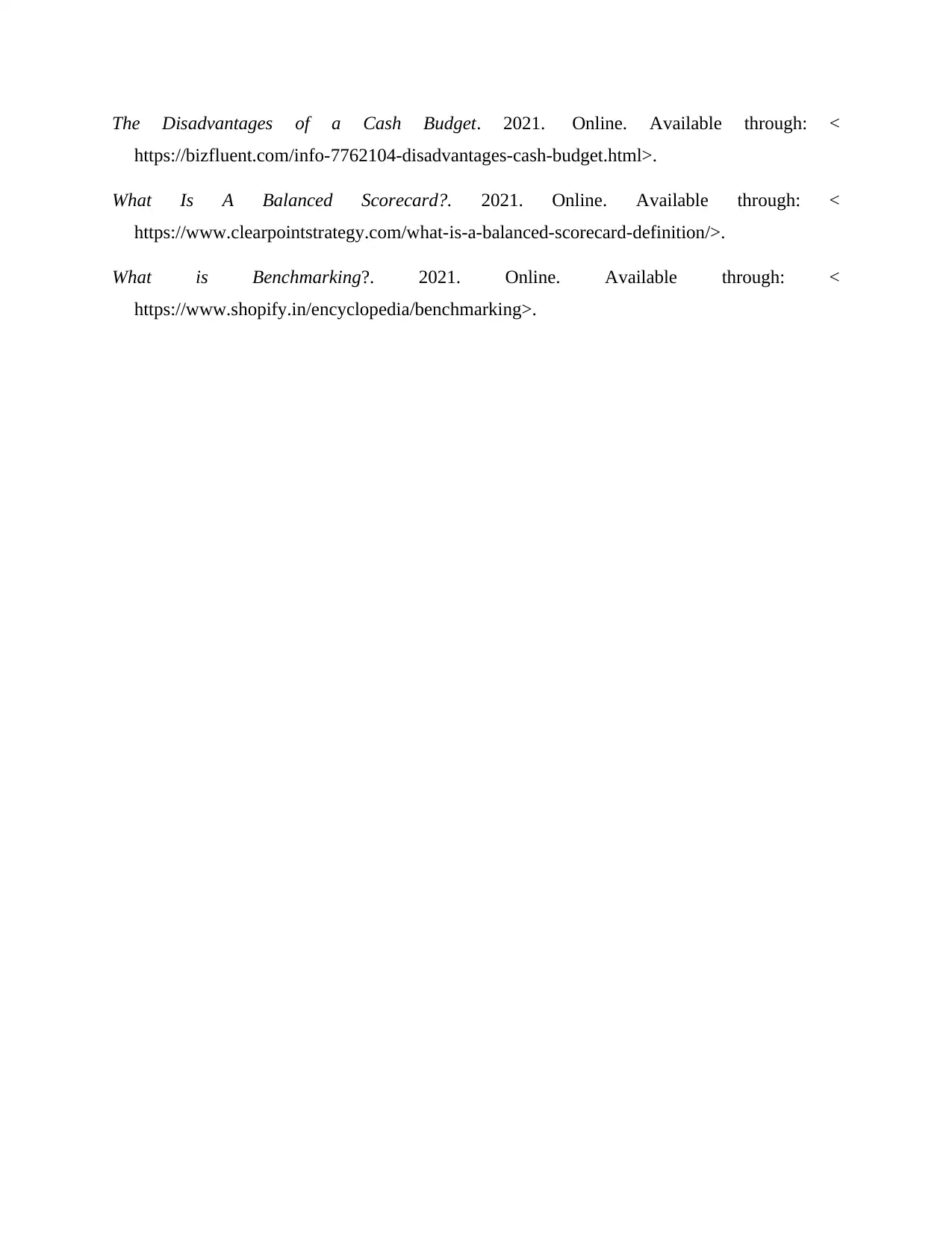
The Disadvantages of a Cash Budget. 2021. Online. Available through: <
https://bizfluent.com/info-7762104-disadvantages-cash-budget.html>.
What Is A Balanced Scorecard?. 2021. Online. Available through: <
https://www.clearpointstrategy.com/what-is-a-balanced-scorecard-definition/>.
What is Benchmarking?. 2021. Online. Available through: <
https://www.shopify.in/encyclopedia/benchmarking>.
https://bizfluent.com/info-7762104-disadvantages-cash-budget.html>.
What Is A Balanced Scorecard?. 2021. Online. Available through: <
https://www.clearpointstrategy.com/what-is-a-balanced-scorecard-definition/>.
What is Benchmarking?. 2021. Online. Available through: <
https://www.shopify.in/encyclopedia/benchmarking>.
1 out of 16
Related Documents
Your All-in-One AI-Powered Toolkit for Academic Success.
+13062052269
info@desklib.com
Available 24*7 on WhatsApp / Email
![[object Object]](/_next/static/media/star-bottom.7253800d.svg)
Unlock your academic potential
© 2024 | Zucol Services PVT LTD | All rights reserved.





